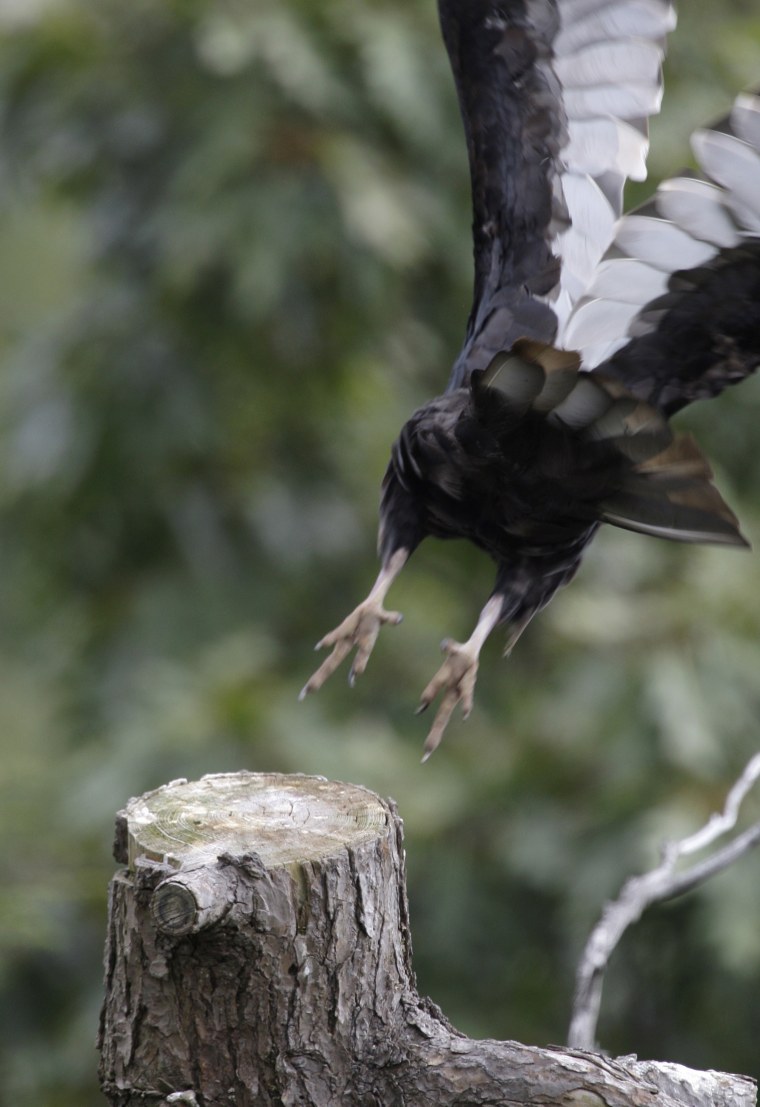Peering through binoculars, Arlene Koch spies something tiny and dark on the horizon. Though it's still a few miles away and difficult to see even with magnification, she can identify the shadowy figure by its shape and the characteristics of its flight.
"That's a broadwing over five," Koch declares from her perch atop Hawk Mountain. "Now we need about 5,000 more to follow!"
Koch is a volunteer hawk counter at Hawk Mountain Sanctuary, a 2,400-acre ridgetop preserve in eastern Pennsylvania where generations have come to watch migrating hawks, eagles and falcons. Joining her this mid-September day are dozens of visitors — casual tourists and birding enthusiasts alike — hoping to catch a huge flight of broadwing hawks.
Situated along a major Appalachian flyway for migratory birds known as the Kittatinny Ridge, Hawk Mountain records an average fall migration of 18,000 to 20,000 raptors. It's one of the best, and best-known, spots in the nation to catch these sharp-beaked birds of prey as they head to warmer climes like Florida, Mexico, and Central and South America.
Each morning from Aug. 15 through Dec. 15, volunteers like Koch trek about a mile over rocky terrain to a famed outcropping called North Lookout. There, they identify and count the 16 species of raptor that use the Kittatinny as a kind of aerial Autobahn. Hawk Mountain has recorded the migration since its founding 75 years ago as the world's first refuge for birds of prey, giving scientists the ability to monitor long-term health and population trends.
The tourists, meanwhile, can just sit back and enjoy the show. Which they do, coming by the thousands each fall.
Despite Koch's exhortation, a big broadwing flight would not be in the cards this day. By early evening, the official count stands at 315. (The season's broadwing peak comes two days later, when 1,613 birds soar over North Lookout.)
Even when it's relatively slow, though, there are wonders to behold. Two sharp-shinned hawks ("sharpies" for short) go at each other in prolonged aerial battle. A small, colorful falcon known as a kestrel streaks overhead, seemingly in a great hurry. There are a few ospreys — none clutching fish, alas — and even a bald eagle.
The afternoon's highlight: a "kettle" or flock of 38 broadwings, spiraling ever-higher in a pocket of warm air called a thermal before peeling off, one by one, to coast down the ridge. Koch takes note of each bird, furiously clicking her hand-held counter. Eventually the hawks are overhead, and several dozen necks crane in unison to watch them. They disappear over the treeline.
Two other species that migrate over Hawk Mountain in large numbers — sharp-shinned and red-tailed hawks — are best seen in early October and early November, respectively. Early November also marks the arrival of small numbers of golden eagles. The peak autumn flight of bald eagles is in early September.
The birds first come into view a few miles from North Lookout, appearing as specks on the horizon. Sightings are announced to the rest of the crowd, with landmarks used as reference points. Koch's "broadwing over five," for example, means that she has spotted a bird over a small hump known as No. 5 on the left side of the ridge.
You don't have to be an expert bird-watcher to enjoy Hawk Mountain, though. Volunteers are happy to answer questions. Koch and her counting partner, Rudy Keller, keep up a running commentary throughout the day.
Any visit to the sanctuary should start at the Visitor Center, where you can buy trail passes, look at scale models of raptors, take in exhibits on raptor migration and behavior, see a live bird demonstration (on weekends only), learn about Hawk Mountain founder Rosalie Edge, and browse the gift shop.
From the trailhead just off Hawk Mountain Road, it's a short walk to the first viewing station, South Lookout. This lookout offers a fine panorama of the Kittatinny Ridge to the left and a 1,600-foot promontory called The Pinnacle to the right. On the unspoiled, green-carpeted valley floor, about 700 feet down, is the River of Rocks, a boulder field nearly a mile long and more than 40 feet deep that was formed during the last ice age.
After several more lookouts, the trail gets rockier, serving up a mildly strenuous but pleasant hike through sun-dappled hardwood forest. Foot bridges take you over marshy sections; benches provide a respite for weary legs. When you get to the long stone staircase, you're only a few minutes from North Lookout.
Your efforts are rewarded with a magnificent view — 50 miles on a clear day — of low, green mountains interspersed with patches of farmland. You'll also notice the replica of a great horned owl sitting atop a wooden pole. It's there to lure raptors, especially sharpies that sometimes attack it as they fly past.
The owl is so lifelike that first-time visitors often mistake it for the real thing. There's no such confusion about the hawks.
